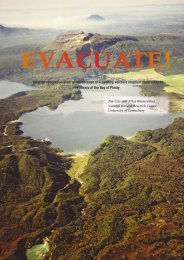Tsunami evacuation: Lessons from the Great East Japan earthquake ...
Tsunami evacuation: Lessons from the Great East Japan earthquake ...
Tsunami evacuation: Lessons from the Great East Japan earthquake ...
Create successful ePaper yourself
Turn your PDF publications into a flip-book with our unique Google optimized e-Paper software.
2012<br />
negative impacts of significant hard defences, which can induce false impressions of safety<br />
and an inability to see <strong>the</strong> natural warning of a disturbed ocean. Even in small events,<br />
unforeseen issues (e.g. break-down and non-closure of gate systems/<strong>earthquake</strong> damage)<br />
may result in unexpected inundation.<br />
The tsunami impacts in Tarō have been widely reported due to <strong>the</strong> damage <strong>the</strong> town<br />
sustained, despite having a concrete sea wall of 10 m height, in three sections with a<br />
combined length of 2,433 m (Tarō Town Municipal Government, n d). This sea wall<br />
prevented damage in <strong>the</strong> town due to <strong>the</strong> 1960 distant Chile tsunami, and would likely<br />
prevent damage to <strong>the</strong> main town in <strong>the</strong> vast majority of tsunami in its design lifetime.<br />
However, on March 11 th , <strong>the</strong> perceived safety in which residents lived may have contributed<br />
to a number of deaths – as already discussed in Section 2.5, <strong>the</strong> presence of <strong>the</strong> wall and<br />
<strong>the</strong> estimated 3 m tsunami height combined such that some people believed <strong>the</strong>y would be<br />
unaffected behind <strong>the</strong> wall. Sixteen people died while driving through Tarō, possibly as a<br />
result of not feeling <strong>the</strong> <strong>earthquake</strong> or at least not being able to sufficiently recognise <strong>the</strong><br />
arriving tsunami due to <strong>the</strong>ir views of <strong>the</strong> sea being obstructed. The disaster prevention<br />
official also reported that some people believed that <strong>the</strong> tsunami spray hitting <strong>the</strong> wall was<br />
fire ra<strong>the</strong>r than waves arriving.<br />
This issue was also apparent in Ryoishi, where several vehicles were observed driving along<br />
<strong>the</strong> coastal road immediately adjacent to a sea wall (Bombaadi, 2011). At <strong>the</strong> time <strong>the</strong>se<br />
vehicles were on <strong>the</strong> road, <strong>the</strong> tsunami was rising rapidly on <strong>the</strong> o<strong>the</strong>r side of <strong>the</strong> wall<br />
unseen by <strong>the</strong> drivers before it poured over <strong>the</strong> top of <strong>the</strong> wall, which was several metres tall.<br />
The reduction in visibility out to sea also endangered <strong>the</strong> lives of fire-fighters in Setai, Miyako<br />
City, who were manually closing tsunami gates when <strong>the</strong>y saw <strong>the</strong> tsunami at <strong>the</strong> last minute<br />
through a small window in <strong>the</strong> gate and were able to drive away.<br />
New Zealand and Washington presently have sea walls (mostly around harbours) designed<br />
only to mitigate normal storm waves and prevent long-term erosion. On coastlines at risk of<br />
a local subduction zone <strong>earthquake</strong>, it is unlikely to be feasible to construct a defence of<br />
sufficient size to protect against <strong>the</strong> maximum potential events – exactly as shown in Tarō.<br />
Sea walls may reduce tsunami velocity and wave heights even if breached or damaged,<br />
however, <strong>the</strong> population of <strong>the</strong> area ‘protected’ by <strong>the</strong> defence must be suitably educated to<br />
know that <strong>the</strong> defence is not a 100% guarantee of safety.<br />
2.7 Vertical <strong>evacuation</strong> buildings<br />
Vertical <strong>evacuation</strong> buildings are designed to provide refuge in <strong>the</strong> inundated area by<br />
providing sufficient elevation above <strong>the</strong> maximum water level. This type of refuge proved to<br />
be extremely valuable in reducing life loss on March 11 th 2011. These buildings are different<br />
to regular <strong>evacuation</strong> centres, which are generally designated in <strong>Japan</strong> for use in multiple<br />
hazards, and are located outside of <strong>the</strong> previously estimated tsunami hazard zone.<br />
The consistent education message delivered to <strong>the</strong> public in Tōhoku was to evacuate inland<br />
or to high ground as priority, but <strong>the</strong> presence of vertical <strong>evacuation</strong> buildings was valuable<br />
in situations where people were unable to get inland or to high ground prior to tsunami<br />
arrival. The successes are numerous; however, some important lessons can also be learnt<br />
<strong>from</strong> <strong>the</strong> experiences of evacuees who used <strong>the</strong>se buildings. Appendix 4 provides a list of<br />
vertical <strong>evacuation</strong> buildings in <strong>the</strong> locations visited, with details on construction, signage,<br />
access, inundation level on 11 th March and number of people saved.<br />
GNS Science Report 2012/17 37

















